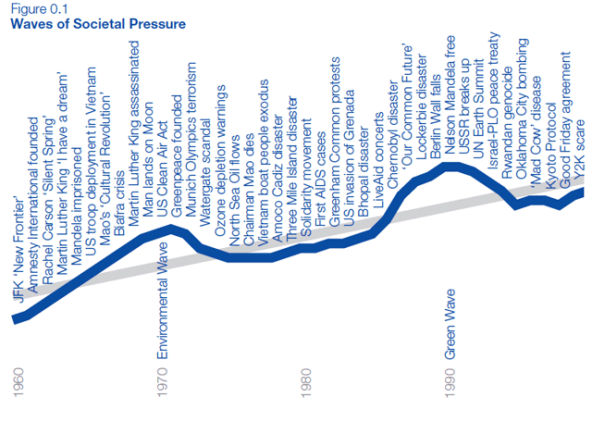When talking about the future, I try to start things off by gauging what “future” really means to people. Inevitably, when asked whether 2050 feels far away, most people are quick to say “yes.”
The year 2050 has been blazed into our collective consciousness by a series of generally agreed statistics and events. By 2050, there will be 9 billion people on the planet. Global food demand will double. We will have exhausted global oil reserves and fish sources, and fresh water will be one of the most valuable commodities on the planet. There will be a 2 degree warming of temperatures globally, resulting in increasingly severe storms, rising water levels, droughts, and heat waves.
But 2050 jumps out in my mind because it is the year that my son will turn 40—just a few years older than I am today. So instead of it being a date in the future to bucket a bunch of monumental global challenges, I try to make it a bit more personal to encourage others to think about the world they want to leave to the next generation.
Earlier this year, Volans published the report “The Future Quotient” to encourage businesses, governments, investors, and individuals to think and act with much longer-term horizons in mind. Our team, led by John Elkington, a man with decades of experience in the sustainability space, looked back over the last 50 years and noted four distinct “waves” of social pressure. Each wave illustrates the public’s rising and falling consciousness about social and environmental challenges.


Are you enjoying this article? Read more like this, plus SSIR's full archive of content, when you subscribe.
Looking at recent waves, in 2011 we saw a series of remarkable events. We watched mass mobilization in the form of the Arab Spring and Occupy Wall Street movements. Heat waves sweated out the United States. The financial markets exploded—culminating in the downgrade of the US credit rating by Standard & Poor. The Euro was in crisis. Riots rocked London—very personally touching our little flat in Clapham where policy helicopters circled our street.
In the grand scheme of things, these events will probably be looked upon as mere ripples leading up to a substantial change in the way we live and work. Hitting the breakthrough trajectory is really the only viable way forward, but it will necessitate very direct strategies to address social inequalities and the growing environmental damage created by the products and services we take for granted today.
The groups within businesses responsible for creating these breakthrough strategies are often found in sustainability teams. And though these groups are becoming increasingly the topic of management guru-speak and mainstream news articles, it is concerning to see signs that the seriousness of how fundamentally different things need to be is still in question.
Take for example a global survey by Accenture and the UN Global Compact. Of the 766 global CEOs surveyed, 93 percent said that they saw sustainability as an important part of the business landscape—a good sign. However, 81 percent said that they had already “embedded” sustainability in their organizations, a distinctly worrying sign. If 81 percent of people running companies think that the problem is solved—then what impetus do they have for further action?
Another survey from 2011 by Weinreb Group found that only 29 publicly listed US companies have a chief sustainability officer and they, on average, only have 4.2 direct reports on their team.
If we want to understand what the term sustainability really means, we need to look back at the definition presented by the Brundtland Commission in 1987. Key to the agenda—led by Gro Harlem Brundtland, who was appointed by UN Secretary General Javier Perez de Cuellar to unite countries to pursue sustainable development—was the issue of long-term and intergenerational timescales and equity. This was an extremely complex issue to address in 1983, when the commission convened, and remains one today. It requires people from all walks of life (but especially those in power) and from all parts of the globe to step outside themselves and build a connection with a future they personally may never meet. It involves implementing difficult decisions, not for the present but for the future.
“The Bruntland Report: Our Common Future” celebrates its 25th anniversary this year. It is reminder of how much more work there is to do. Very few leaders, decision-makers, and policy-makers are truly thinking and acting for the longer term; instead, short-term economic pressures are directing them.
We cannot afford to let companies push sustainability to the periphery of their strategies. We need to do things differently—and innovation is the new call to action. But the focus on innovation needs to capture the urgency of the intergenerational challenge ahead of us.
So let’s not use the language of the past to reflect the direction we need to head in for the future. We need to seize the opportunity to shape this next wave of consciousness and action—because 2050 isn’t that far away.
Support SSIR’s coverage of cross-sector solutions to global challenges.
Help us further the reach of innovative ideas. Donate today.
Read more stories by Charmian Love.

